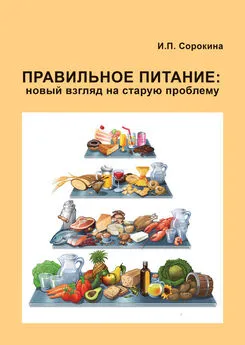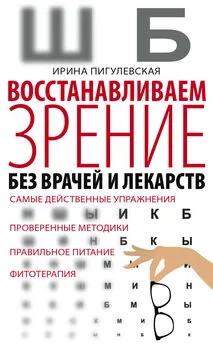Ирина Брехт - Правильное питание как минное поле
- Название:Правильное питание как минное поле
- Автор:
- Жанр:
- Издательство:ООО «ЛитРес», www.litres.ru
- Год:2019
- ISBN:нет данных
- Рейтинг:
- Избранное:Добавить в избранное
-
Отзывы:
-
Ваша оценка:
Ирина Брехт - Правильное питание как минное поле краткое содержание
Правильное питание как минное поле - читать онлайн бесплатно ознакомительный отрывок
Интервал:
Закладка:
34. Shin A, Li H, Shu XO, Yang G, Gao YT, Zheng W. Dietary intake of calcium, fiber and other micronutrients in relation to colorectal cancer risk: Results from the Shanghai Women’s Health Study. Int J Cancer. 2006;119:2938–2942.
35. Park Y, Hunter DJ, Spiegelman D, Bergkvist L, Berrino F, van den Brandt PA, Buring JE, Colditz GA, Freudenheim JL, Fuchs CS, et al. Dietary fiber intake and risk of colorectal cancer: a pooled analysis of prospective cohort studies. JAMA. 2005;294:2849–2857.
36. Asano T, McLeod RS. Dietary fibre for the prevention of colorectal adenomas and carcinomas. Cochrane Database Syst Rev. 2002:CD003430.
37. Marlett JA, McBurney MI, Slavin JL. Position of the American Dietetic Association: health implications of dietary fiber. J Am Diet Assoc. 2002;102:993—1000.
38. Kumar V, Sinha AK, Makkar HP, de Boeck G, Becker K. Dietary roles of non-starch polysaccharides in human nutrition: a review. Crit Rev Food Sci Nutr. 2012;52(10):899–935. doi: 10.1080/10408398.2010.512671.
39. Roberfroid M et al. Prebiotic effects: metabolic and health benefits. Br J Nutr. 2010 Aug;104 Suppl 2:S1—63. doi: 10.1017/S0007114510003363.
40. Pool-Zobel BL. Inulin-type fructans and reduction in colon cancer risk: review of experimental and human data. Br J Nutr. 2005 Apr;93 Suppl 1:S73—90.
41. Cummings JH, Bingham SA. Dietary fibre, fermentation and large bowel cancer. Cancer Surv. 1987;6(4):601—21.
42. Williams EA, Coxhead JM, Mathers JC. Anti-cancer effects of butyrate: use of micro-array technology to investigate mechanisms. Proc Nutr Soc. 2003 Feb;62(1):107—15.
43. Zeng H, Lazarova DL, Bordonaro M. Mechanisms linking dietary fiber, gut microbiota and colon cancer prevention. World Journal of Gastrointestinal Oncology. 2014;6(2):41–51. doi:10.4251/wjgo.v6.i2.41.
44. Moro, G, Arslanoglu, S, Stahl, B, et al. (2006) A mixture of prebiotic oligosaccharides reduces the incidence of atopic dermatitis during the first six months of age. Arch Dis Child 91, 814–819.
45. Bruzzese, E, Volpicelli, M, Squeglia, V, et al. (2009) A formula containing galacto- and fructo-oligosaccharides prevents intestinal and extra-intestinal infections: an observational study. Clin Nutr 28, 156–161.
46. The WHO Fruit and Vegetable survey – definitions and recommended intakes http://www.who.int/dietphysicalactivity/media/gs_fv_ppt_ikeller.pdf
47. Oyinlola Oyebode, Vanessa Gordon-Dseagu, Alice Walker, Jennifer S Mindell. Fruit and vegetable consumption and all-cause, cancer and CVD mortality: analysis of Health Survey for England data.
48. Kathryn A Kaiser et al. Increased fruit and vegetable intake has no discernible effect on weight loss: a systematic review and meta-analysis. he American Journal of Clinical Nutrition, Volume 100, Issue 2, 1 August 2014, Pages 567–576, https://doi.org/10.3945/ajcn.114.090548
49. Shah, M., et al., Effect of a High-Fiber Diet Compared With a Moderate-Fiber Diet on Calcium and Other Mineral Balances in Subjects With Type 2 Diabetes. Diabetes Care, 2009. 32(6): p. 990–995.
50. Whybrow S. Energy density and weight control. In: Mela D. J., editor. Food, Diet and Obesity. Abington, UK: Woodhead Publishing Limited; 2005. pp. 179–203.
51. Rolls BJ, Bell EA, Thorwart ML. Water incorporated into a food but not served with a food decreases energy intake in lean women. Am J Clin Nutr. 1999 Oct; 70(4):448—55.
52. Wendy J. Dahl et al. Health Benefits of Fiber Fermentation, Journal of the American College of Nutrition, 10.1080/07315724.2016.1188737, 36, 2, (127–136), (2017).
Часть 2. Глава 11.
1. Klaas R Westerterp. 2004. Diet induced thermogenesis. Nutrition & Metabolism Journal. 10.1186/1743—7075—1–5.
2. Kant AK. Evidence for Efficacy and Effectiveness of Changes in Eating Frequency for Body Weight Management. Advances in Nutrition. 2014;5(6):822–828. doi:10.3945/an.114.007096.
3. Hall KD Heymsfield SB Kemnitz JWet al. Energy balance and its components: implications for body weight regulation. Am J Clin Nutr. 2012;95:989–994.
4. Kinabo JL Durnin JV. Effect of meal frequency on the thermic effect of food in women. Eur J Clin Nutr. 1990;44:389–395.
5. Ohkawara K Cornier MA Kohrt WMet al. Effects of increased meal frequency on fat oxidation and perceived hunger. Obesity. 2013;21:336–343.
6. Verboeket-van de Venne WP Westerterp KR. Influence of the feeding frequency on nutrient utilization in man: consequences for energy metabolism. Eur J Clin Nutr. 1991;45:161–169.
7. Tai MM Castillo P Pi-Sunyer FX. Meal size and frequency: effect on the thermic effect of food. Am J Clin Nutr. 1991;54:783–787.
8. Stote KS Baer DJ Spears Ket al. . A controlled trial of reduced meal frequency without caloric restriction in healthy, normal-weight, middle-aged adults. Am J Clin Nutr. 2007;85:981–988.
9. Speechly DP Buffenstein R. Greater appetite control associated with an increased frequency of eating in lean males. Appetite. 1999;33:285–297.
10. Speechly DP Rogers GG Buffenstein R. Acute appetite reduction associated with an increased frequency of eating in obese males. Int J Obes Relat Metab Disord. 1999;23:1151–1159.
11. Smeets AJ Westerterp-Plantenga MS. Acute effects on metabolism and appetite profile of one meal difference in the lower range of meal frequency. Br J Nutr. 2008;99:1316–1321.
12. Cameron JD Cyr MJ Doucet E. Increased meal frequency does not promote greater weight loss in subjects who were prescribed an 8-week equi-energetic energy-restricted diet. Br J Nutr. 2010;103:1098–1101.
13. Leidy HJ Tang M Armstrong CLet al. The effects of consuming frequent, higher protein meals on appetite and satiety during weight loss in overweight/obese men. Obesity. 2011;19:818–824.
14. Leidy HJ Armstrong CL Tang Met al. The influence of higher protein intake and greater eating frequency on appetite control in overweight and obese men. Obesity. 2010;18:1725–1732.
15. Ohkawara K Cornier MA Kohrt WMet al. Effects of increased meal frequency on fat oxidation and perceived hunger. Obesity. 2013;21:336–343.
16. Schoenfeld BJ, Krieger J, Aragon FA. 2015. Effects of meal frequency on weight loss and body composition: A meta-analysis. 0.1093/nutrit/nuu017.
17. Bellisle F, McDevitt R, Prentice AM. 1997. Meal frequency and energy balance. The British Journal of Nutrition. 1: S57—70.
18. Kulovitz MG, Kravitz LR, Mermier C, Gibson AL, Conn CA, Kolkmeyer D, Kerksick CM. 2013. Potential role of meal frequency as a strategy for weight loss and health in overweight or obese adults. The Nutrition. 10.1016/j.nut.2013.08.009.
19. Cho S et al. The effect of breakfast type on total daily energy intake and body mass index: results from the Third National Health and Nutrition Examination Survey (NHANES III). J Am Coll Nutr. 2003 Aug;22(4):296–302.
20. de la Hunty A, Gibson S, Ashwell M. Does regular breakfast cereal consumption help children and adolescents stay slimmer? A systematic review and meta-analysis. Obes Facts. 2013;6(1):70–85. doi: 10.1159/000348878.
21. Uemura M et al. Breakfast Skipping is Positively Associated With Incidence of Type 2 Diabetes Mellitus: Evidence From the Aichi Workers’ Cohort Study. J Epidemiol. 2015;25(5):351—8. doi: 10.2188/jea.JE20140109.
22. Reutrakul S et al. The relationship between breakfast skipping, chronotype, and glycemic control in type 2 diabetes. Chronobiol Int. 2014 Feb;31(1):64–71. doi: 10.3109/07420528.2013.821614.
23. Betts JA, Richardson JD, Chowdhury EA, Holman GD, Tsintzas K, Thompson D. 2014. The causal role of breakfast in energy balance and health: a randomized controlled trial in lean adults. The American Journal of Clinical Nutrition. 100(2): 539–547.
24. Dhurandhar EJ et al. 2014. The effectiveness of breakfast recommendations on weight loss: a randomized controlled trial. The American Journal of Clinical Nutrition.100(2): 507–513.
25. Versteeg RI, Ackermans MT, Nederveen AJ, Fliers E, Serlie MJ, la Fleur SE. Meal timing effects on insulin sensitivity and intrahepatic triglycerides during weight loss. Int J Obes (Lond). 2018 Feb; 42(2): 156–162.
26. Allan Geliebter et al. 2014. Skipping breakfast leads to weight loss but also elevated cholesterol compared with consuming daily breakfasts of oat porridge or frosted cornflakes in overweight individuals: a randomised controlled trial. Journal of Nutritional Science.10.1017/jns.2014.51.
27. LeCheminant GM, LeCheminant JD, Tucker LA, Bailey BW. A randomized controlled trial to study the effects of breakfast on energy intake, physical activity, and body fat in women who are non habitual breakfast eaters. Appetite. 2017 May 1;112:44–51. doi: 10.1016/j.appet.2016.12.041.
28. Marie-Pierre St-Onge et al. Meal Timing and Frequency: Implications for Cardiovascular Disease Prevention: A Scientific Statement From the American Heart Association. AHA SCIENTIFIC STATEMENT. 2017;135:e96-e121 doi.org/10.1161/CIR.0000000000000476
29. Schlundt DG, Hill JO, Sbrocco T, Pope-Cordle J, Sharp T. The role of breakfast in the treatment of obesity: a randomized clinical trial. Am J Clin Nutr 1992;55:645—51.
30. Farshchi HR, Taylor MA, Macdonald IA. Deleterious effects of omitting breakfast on insulin sensitivity and fasting lipid profiles in healthy lean women. Am J Clin Nutr 2005;81:388—96.
31. Heather J Leidy et al. Evaluating the Intervention-Based Evidence Surrounding the Causal Role of Breakfast on Markers of Weight Management, with Specific Focus on Breakfast Composition and Size, Advances in Nutrition, Volume 7, Issue 3, 1 May 2016, Pages 563S—575S, https://doi.org/10.3945/an.115.010223
32. Keys, A., Brozek, J., Henshel, A., Mickelson, O., & Taylor, H.L. (1950). The biology of human starvation, (Vols. 1–2). Minneapolis, MN: University of Minnesota Press.
33. Friedman JM, Halaas JL. Leptin and the regulation of body weight in mammals. Nature. 1998 Oct 22; 395(6704):763—70.
34. Ahima RS, Prabakaran D, Mantzoros C, Qu D, Lowell B, Maratos-Flier E, Flier JS. Role of leptin in the neuroendocrine response to fasting. Nature. 1996 Jul 18; 382(6588):250—2.
35. Schwartz MW, Seeley RJ. Seminars in medicine of the Beth Israel Deaconess Medical Center. Neuroendocrine responses to starvation and weight loss. N Engl J Med. 1997 Jun 19; 336(25):1802—11.
36. Dallman MF Et al. Starvation: early signals, sensors, and sequelae. Endocrinology. 1999 Sep;140(9):4015—23.
37. P. VUJOVIC et al. Time-Dependent Effects of Starvation on Serum, Pituitary and Hypothalamic Leptin Levels in Rats. Physiol. Res. 60 (Suppl. 1): S165-S170, 2011
38. Chan JL, Heist K, DePaoli AM, Veldhuis JD, Mantzoros CS. The role of falling leptin levels in the neuroendocrine and metabolic adaptation to short-term starvation in healthy men. Journal of Clinical Investigation. 2003;111(9):1409–1421. doi:10.1172/JCI200317490.
39. Sofer S, Eliraz A, Kaplan S, Voet H, Fink G, Kima T, Madar Z. 2011. Greater weight loss and hormonal changes after 6 months diet with carbohydrates eaten mostly at dinner. The Obesity Journal. 19(10): 2006–2014.
40. Alves RD et al. Eating carbohydrate mostly at lunch and protein mostly at dinner within a covert hypocaloric diet influences morning glucose homeostasis in overweight/obese men. Eur J Nutr. 2014 Feb;53(1):49–60. doi: 10.1007/s00394—013—0497—7.
41. Fong M, Caterson ID1, Madigan CD1. Are large dinners associated with excess weight, and does eating a smaller dinner achieve greater weight loss? A systematic review and meta-analysis. Br J Nutr. 2017 Oct;118(8):616–628. doi: 10.1017/S0007114517002550.
42. Katayose Y, Tasaki M, Ogata H, Nakata Y, Tokuyama K, Satoh M. Metabolic rate and fuel utilization during sleep assessed by whole-body indirect calorimetry. Metabolism. 2009 Jul; 58(7):920—6.
Читать дальшеИнтервал:
Закладка:








![Артем Каменистый - Правильное питание [СИ]](/books/1146496/artem-kamenistyj-pravilnoe-pitanie-si.webp)

